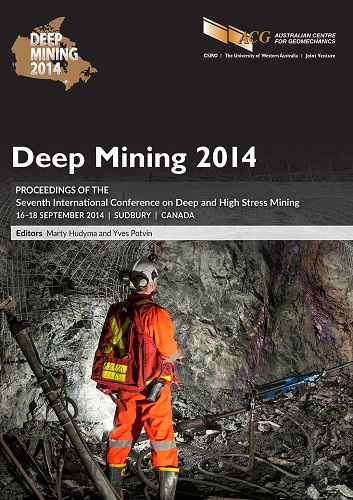Using clustering algorithms to assist short-term seismic hazard analysis in deep South African mines

|
Authors: Rebuli, DB; Kohler, SJ |
DOI https://doi.org/10.36487/ACG_rep/1410_50_Rebuli
Cite As:
Rebuli, DB & Kohler, SJ 2014, 'Using clustering algorithms to assist short-term seismic hazard analysis in deep South African mines', in M Hudyma & Y Potvin (eds), Deep Mining 2014: Proceedings of the Seventh International Conference on Deep and High Stress Mining, Australian Centre for Geomechanics, Perth, pp. 699-708, https://doi.org/10.36487/ACG_rep/1410_50_Rebuli
Abstract:
Short-term seismic hazard based on the stability analysis methods of the 1990s is part of the deep mine culture of South African mines. Temporal precursory patterns have shown some level of success not only in deep gold mines but also in shallower mines in Australia. In complex geological and mining environments precursory patterns in temporal trends can be lost due to multiple processes mixing and diluting these trends. It is not always possible to separate these mixed processes by refining the traditional spatial filters, making analysis of these regions difficult. This paper proposes the use of an unsupervised learning algorithm to categorise seismic data with the intention of separating different seismogenic processes. This algorithm should not only take spatial and temporal parameters into consideration but should include parameters related to seismic sources, e.g. energy index, ES /EP ratio, etc. In this investigation, an implementation of the DBSCAN clustering algorithm to categorise seismic data was used. This density based algorithm requires only two parameters: the maximum search distance, ρ , and the minimum number of neighbours required to form a cluster, . The advantages of DBSCAN include its ability to create any number of clusters to suit the data set as well as its ability to identify noise and outliers. DBSCAN can struggle to cluster data sets where there are large differences in densities, since there may not be an appropriate choice of and for all clusters. We investigate a few cases where multi-dimensional clustering indicates precursory trends. More specifically examples of density clustering of spatial-and-temporal and spatial-and-source clustering are discussed.
References:
Brink, A & Mountfort, P 1984, ‘Feasibility studies on the prediction of rockbursts at Western Deep Levels’, in NC Gay & EH Wainwright (eds), Proceedings of 1st International Congress on Rockbursts and Seismicity in Mines, South African Institute of Mining and Metallurgy, Johannesburg, pp. 317-325.
Ester, M, Kriegel, H, Sander, J & Xu, X 1996, ‘A Density-Based Algorithm for Discovering Clusters in Large Spatial Databases with Noise’, in E Simoudis, J Han & U Fayyad (eds), Proceedings of the 2nd International Conference on Knowledge Discovery and Data Mining, Association for the Advancement of Artificial Intelligence, Portland, pp. 226-231.
Hills, P, Rebuli, D & Lynch, R 2013, ‘Micro-Seismic Monitoring at the Tasmania mine, Beaconsfield, Tasmania’, in A Malovichko & D Malovichko (eds), Proceedings of 8th International Symposium on Rockbursts and Seismicity in Mines, Geophysical Survey of Russian Academy of Sciences, Obninsk, Mining Institute of Ural Branch of Russian Academy of Sciences, Perm,
pp. 485-494.
Mendecki, AJ 1997, Seismic Monitoring in Mines, Chapman & Hall, London.
Milligan, G & Cooper, M 1988, 'A study of standardization of variables in cluster analysis', Journal of Classification, vol. 5,
pp. 181-204.
Rebuli, D & van Aswegen, G 2013, 'Short term seismic hazard assessment in S.A. gold mines', in A Malovichko & D Malovichko (eds), Proceedings of 8th International Symposium on Rockbursts and Seismicity in Mines, Geophysical Survey of Russian Academy of Sciences, Obninsk, Mining Institute of Ural Branch of Russian Academy of Sciences, Perm, pp. 323-331.
van Aswegen, G 2005, ‘Routine seismic hazard assessment in some South African mines’, in Y Potvin & M Hudyma (eds), Proceedings of Sixth International Symposium on Rockburst and Seismicity in Mines, Australian Centre of Geomechanics, Perth, pp. 437-444.
© Copyright 2025, Australian Centre for Geomechanics (ACG), The University of Western Australia. All rights reserved.
View copyright/legal information
Please direct any queries or error reports to repository-acg@uwa.edu.au
View copyright/legal information
Please direct any queries or error reports to repository-acg@uwa.edu.au